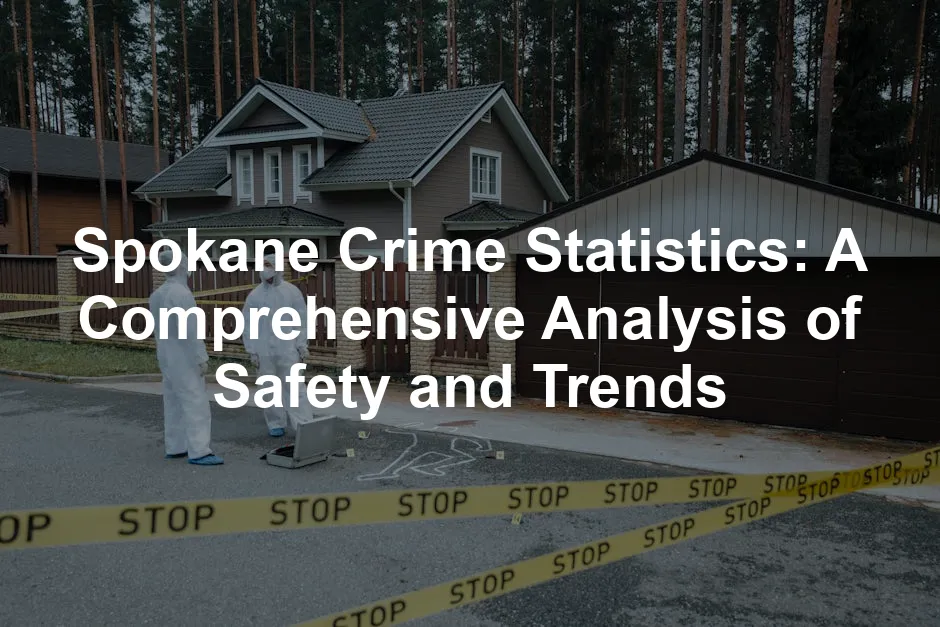Introduction
Ah, Spokane! Known for its stunning scenery and vibrant community, but also for a rather alarming reputation regarding crime. Yes, folks, crime in Spokane, Washington, is a topic that deserves our attention. When you hear “high crime rate,” it’s easy to picture a bustling city filled with chaos. However, understanding the nuances of these statistics can provide valuable insights for residents, potential movers, and even policymakers.
Let’s face it; knowing the crime statistics isn’t just about keeping up with the latest gossip. It’s crucial for making informed decisions about where to live and how to stay safe. Whether you’re considering relocating to Spokane or simply want to feel secure in your neighborhood, these statistics help paint a clearer picture of the safety landscape.
In this article, we’ll break down the crime data, explore trends, and compare Spokane’s statistics with state and national averages. By the end of this, you’ll have a better grasp of what’s happening in Spokane, so let’s dive into the numbers and see what they reveal.

Overview of Spokane Crime Statistics
General Crime Data
Let’s get straight to the point: Spokane reported a staggering total of 14,694 crimes last year. That translates to an overall crime rate of about 63.84 incidents per 1,000 residents. Yes, you read that right—64 crimes for every 1,000 people!
What about the nitty-gritty details? Out of those reported crimes, 1,541 were classified as violent. That leaves a hefty 13,153 property crimes. For local residents, these numbers may feel like a wake-up call. High crime rates can impact everything from property values to personal safety, making it essential to stay informed.
If you want to stay safe at home, consider investing in a Home Security System with Camera. It’s like having an extra set of eyes on your property, ensuring that you can enjoy your beautiful surroundings without worrying about potential intruders.

Crime Rate Comparison
Now, let’s compare Spokane’s crime rates with those of Washington State and the national averages. The violent crime rate in Spokane stands at 6.70, significantly higher than Washington’s average of 3.76 and the national median of 4.0. When it comes to property crimes, Spokane’s rate hits 57.15, dwarfing Washington’s rate of 33.56 and the national median of 20.0.
What does this mean for Spokane residents? It suggests that, compared to other areas, Spokane faces a higher risk of both violent and property crimes. These figures can stir some serious concerns regarding safety. However, knowledge is power! By being aware of these statistics, residents can take proactive steps to enhance their personal safety and advocate for community improvements.
One way to boost your personal security is by carrying a Personal Safety Alarm. This little device can be a lifesaver, helping you to alert others in case of an emergency. It’s like having your very own safety whistle, but with a modern twist!

Understanding the importance of crime statistics can help residents make informed decisions about their safety. Spokane crime statistics are crucial for this process.
In summary, Spokane’s crime statistics paint a complex picture. While the numbers may be daunting, they also highlight the importance of community engagement and awareness. The more informed residents are, the better equipped they are to contribute to a safer Spokane. So, buckle up as we continue to explore the trends, types of crimes, and what they mean for you!

Breakdown of Violent Crimes
Types of Violent Crimes
Let’s break down Spokane’s violent crimes like a piñata at a birthday party! According to the latest statistics, Spokane reported 1,541 violent crimes last year. Here’s the juicy breakdown:
- Murder: 18
- Rape: 194
- Robbery: 309
- Assault: 1,020
That’s right! Assault tops the list, and it’s not just a small number. With 1,020 incidents, it’s clear that staying vigilant is key.
Now, let’s talk numbers. The violent crime rate in Spokane is approximately 6.70 per 1,000 residents. If you’re living in Spokane, your chances of becoming a victim of a violent crime? About 1 in 149. Those odds might sound better than winning the lottery, but they’re still not exactly comforting!
So, what does being a victim of violence feel like? Imagine walking down the street, and suddenly you trip over a rock called “murder” or “robbery.” It’s a harsh reality that can shake anyone to their core. Understanding these statistics is crucial for residents and those considering a move to this vibrant city.

Recent Trends in Violent Crime
Now, let’s put on our detective hats and analyze recent trends in violent crime rates. Over the last few years, Spokane has seen some fluctuations. While the overall crime rates have increased, violent crimes in particular have also jumped by about 6%.
What could be causing this uptick? A cocktail of socio-economic factors! For starters, unemployment rates have lingered around 3.7%, slightly below the national average. However, economic distress remains a significant player in the crime game.
Additionally, the availability of drugs and gang activity adds fuel to the fire. With poverty levels affecting many families, the temptation to engage in criminal activities can rise. It’s like living in a game where the stakes are high, and the odds seem stacked against you.
What can we conclude? A mix of economic pressure and community dynamics may contribute to these trends. By understanding these factors, Spokane residents can better prepare and respond to the challenges their community faces. After all, knowledge is as powerful as a superhero cape when it comes to safety!

The statistics can feel overwhelming, but they also serve as a wake-up call for the community. Residents are encouraged to engage with local initiatives, advocate for change, and work together towards a safer Spokane.
Neighborhood Crime Rates in Spokane
Crime Rates by Neighborhood
When it comes to Spokane, not all neighborhoods are created equal in terms of safety. Some areas shine like a diamond in a coal mine, while others might feel like a scene from a thriller movie.
Starting with the safer havens, we have Manitocannon Hill, Lincoln Heights, and North Indian Trail. These neighborhoods are known for their lower crime rates and a sense of community that keeps residents feeling secure. It’s like living in a cozy bubble where the biggest worry is whether to go for a morning jog or hit the snooze button one more time.
On the flip side, some neighborhoods raise eyebrows with their higher crime rates. West Central, Hillyard, and Whitman are known for being hotspots of crime. Residents here might feel like they’re living in a continuous suspenseful saga, where safety is often a concern. These areas see more reports of burglaries and theft, which can cast a shadow over the community vibe.

Consider installing a Motion Sensor Security Light to deter potential intruders. Bright lights can turn your home into a fortress, shining a spotlight on any unwelcome guests!
The stark contrast between these neighborhoods is a reminder that safety can vary tremendously within a single city. As potential residents explore Spokane, being aware of neighborhood crime rates can guide their decisions.

Community Safety Perceptions
How safe do residents feel in their neighborhoods? A recent survey sheds light on these perceptions. Surprisingly, a whopping 74% of residents expressed concerns about crime, stating they feel unsafe walking alone at night. That’s a lot of folks looking over their shoulders!
However, not all feedback is negative. Many community initiatives aim to boost safety and build connections. Programs like neighborhood watch groups and community patrols are stepping up to address crime concerns. They’re like your friendly neighborhood superheroes, minus the capes (and maybe with a bit less flair).
In safer neighborhoods like Manitocannon Hill, residents often report feeling more secure. This is attributed to strong community ties and active engagement in local safety programs. It’s all about creating an environment where everyone feels responsible for looking out for each other—much like your grandma keeping an eye on the neighborhood kids.

In contrast, areas with higher crime rates like Hillyard often struggle with safety perceptions. Residents feel the pinch of crime-related anxiety, influencing their daily lives. However, community leaders are working tirelessly to implement solutions. They’re not just rolling up their sleeves; they’re getting creative with crime prevention strategies that focus on youth engagement and economic opportunities.
Want to take your personal safety to the next level? A Pepper Spray for Self-Defense can be a practical addition to your safety toolkit. It’s small, easy to carry, and can give you the confidence boost you need when walking alone at night.

In summary, Spokane’s neighborhoods present a varied landscape of crime rates and community perceptions. While some areas bask in the warmth of safety, others face challenges that require collective action. For anyone considering a move to Spokane, keeping an eye on neighborhood dynamics can be crucial for both safety and peace of mind.
Resources and Data Sources
Key Data Sources
Understanding crime statistics in Spokane requires reliable data sources. The primary providers include local law enforcement agencies, such as the Spokane Police Department, and national databases like the FBI’s Uniform Crime Reporting (UCR) program.

The Spokane Police Department regularly publishes CompStat reports. These reports analyze crime trends and offender behavior. They help allocate police resources effectively. The department is transitioning to the National Incident-Based Reporting System (NIBRS) for more detailed crime statistics, which is a positive move towards transparency.
At the national level, the FBI compiles data from thousands of law enforcement agencies. This data showcases crime trends and comparisons across states and cities. Websites like NeighborhoodScout and AreaVibes also provide insights into crime statistics, offering a user-friendly interface for residents and researchers alike.
The importance of transparency cannot be overstated. Accessible crime data promotes community awareness and encourages participation in safety initiatives. When residents are informed about crime trends, they can make better decisions regarding safety and community engagement.
Tools for Residents
Residents in Spokane have access to various tools for understanding crime in their neighborhoods. One of the most useful resources is the interactive crime map available through the Spokane Valley website. This map allows users to filter crime data by type and timeframe, providing a visual representation of crime distribution.

Additionally, the Spokane Police Department publishes regular crime statistics reports. These reports summarize monthly crime incidents, helping residents stay informed about local safety issues.
Community engagement is crucial for crime prevention. Residents are encouraged to participate in neighborhood watch programs and local safety initiatives. By working together, communities can foster a safer environment. Awareness is the first step in crime prevention, and utilizing available tools can significantly enhance community safety.
Conclusion
As we’ve sifted through the crime statistics in Spokane, a clearer picture emerges. The city faces significant challenges with both violent and property crimes. Unfortunately, Spokane’s crime rates are notably higher than state and national averages.
The statistics reveal a pressing need for community involvement in safety initiatives. When residents are informed and engaged, they can advocate for change and promote safer neighborhoods. Awareness and proactive measures can transform perceptions of safety within the community.

Moreover, utilizing available resources and data can empower residents. By accessing crime reports, interactive maps, and local programs, Spokane’s citizens can contribute to a collective effort in reducing crime.
If you’re considering ways to be prepared for emergencies, an Emergency Preparedness Kit is an essential item. It ensures you’re ready for any unexpected situations, from power outages to natural disasters.

In summary, understanding Spokane’s crime statistics is essential for both current residents and those considering a move. While the numbers may be concerning, they also serve as a call to action for community engagement. Together, Spokane can aspire to improve safety and foster a more secure environment for all its residents.
FAQs
What is the overall crime rate in Spokane?
Spokane has a total of 14,694 reported crimes, translating to about 64 crimes per 1,000 residents. This includes 1,541 violent crimes and 13,153 property crimes. So, if you’re walking downtown, you’re looking at a 1 in 16 chance of becoming a victim of crime. Yikes! For context, the violent crime rate of 6.70 per 1,000 residents is significantly higher than Washington’s average of 3.76 and the national median of 4.0.
How does Spokane’s crime rate compare nationally?
Spokane doesn’t exactly win the gold medal for safety. Its violent crime rate is 433.1 per 100,000 people, which is higher than the national average. Property crime rates are even more alarming, with Spokane at 5,736 incidents per 100,000 people—about 194% above the national average. So, if you’re thinking of moving here, keep that in mind!
What neighborhoods in Spokane are considered safe?
If you’re searching for safer havens in Spokane, look no further than Manitocannon Hill, Lincoln Heights, and North Indian Trail. These neighborhoods boast low crime rates, friendly neighbors, and a sense of community. They’re the type of places where you can let your kids ride their bikes without worrying about what’s lurking around the corner.
What resources are available for Spokane residents concerned about crime?
Spokane residents can access various resources. The Spokane Police Department provides crime statistics, safety tips, and community programs. Local neighborhood watch groups are also active and ready to help residents stay informed. Interactive crime maps are available, allowing you to see crime trends in real-time. Remember, knowledge is power, and staying informed is your best defense!
What trends have been observed in Spokane’s crime statistics in recent years?
Recent data indicates a concerning trend: Spokane’s total crime rates have surged by 21% year-over-year. Violent crime has shot up by 6%, while property crime has skyrocketed by 23.1%. Factors like economic stress and community dynamics are contributing to these increases. It’s a wake-up call for all residents to engage more actively in local safety initiatives. The community must come together to address these issues head-on!
Please let us know what you think about our content by leaving a comment down below!
Thank you for reading till here 🙂
All images from Pexels




